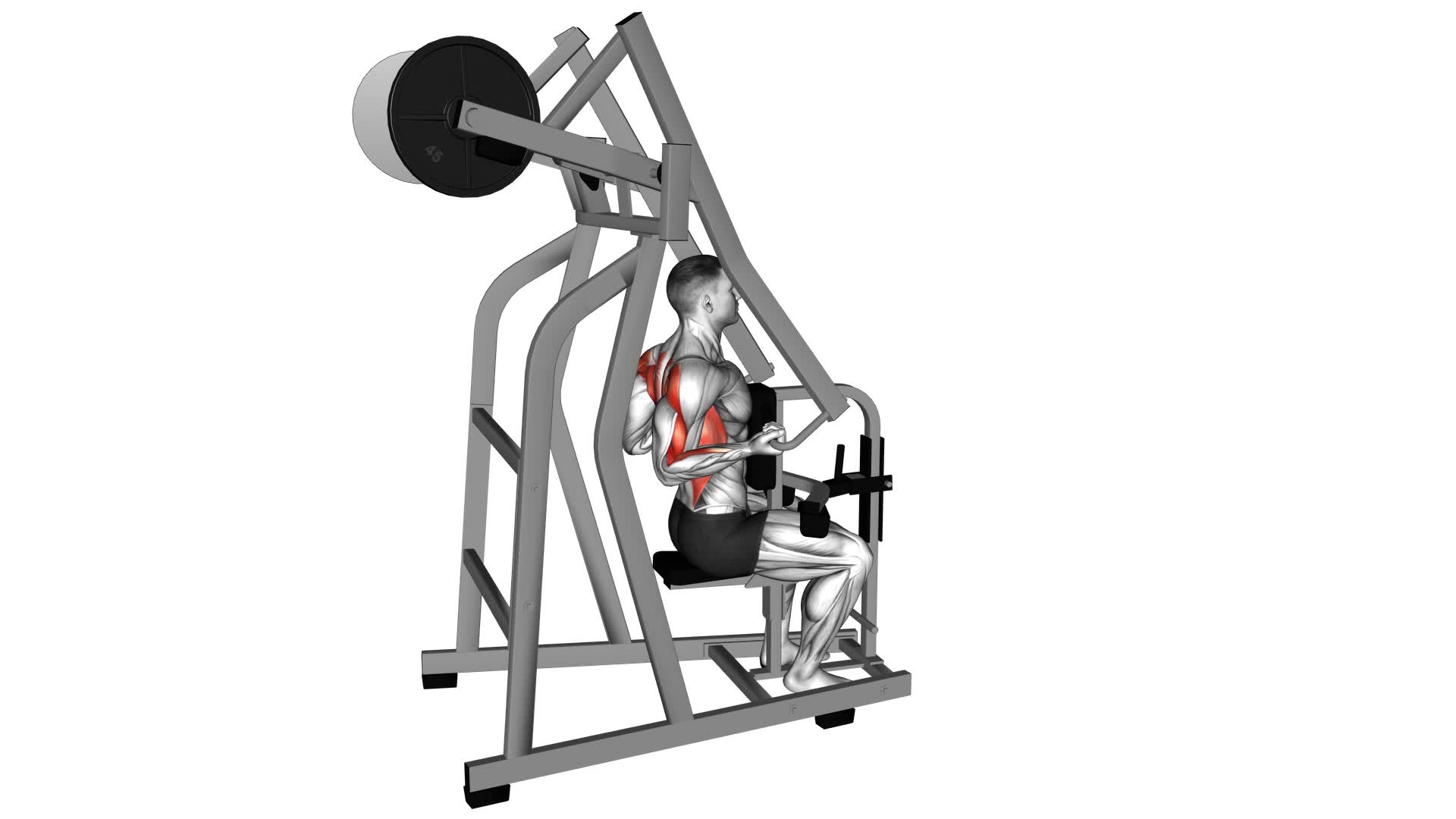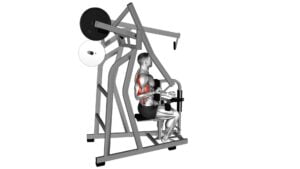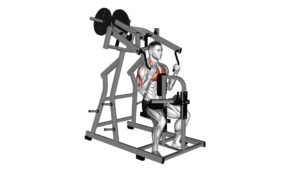Lever Reverse Grip High Row (Plate Loaded) – Video Exercise Guide & Tips

Are you looking for an effective upper body exercise that targets your back muscles? Look no further!
Watch This Exercise Video
In this video exercise guide, we'll show you how to perform the Lever Reverse Grip High Row using a plate loaded machine.
By using a second person point of view, active voice, and contractions, we'll guide you through the proper form, variations, and common mistakes to avoid.
Get ready to maximize your results and achieve a stronger back!
Key Takeaways
- Lever Reverse Grip High Row targets latissimus dorsi, rhomboids, and middle trapezius muscles.
- It improves posture and promotes a more upright position.
- Varying the exercise prevents plateaus in strength training routine.
- Foam rolling and stretching are effective recovery strategies to prevent muscle imbalances and enhance athletic performance.
Benefits of Lever Reverse Grip High Row
To maximize your upper body strength and target your back muscles effectively, perform the Lever Reverse Grip High Row exercise. This exercise specifically targets your latissimus dorsi, rhomboids, and middle trapezius muscles, helping you develop a strong and well-defined back. By using a reverse grip, you engage these muscles in a different way compared to traditional rowing exercises, leading to increased back strength.
The Lever Reverse Grip High Row is an excellent exercise for building upper body strength and improving posture. As you pull the weight towards your body, your latissimus dorsi muscles are activated, which are responsible for the width of your back. Additionally, the rhomboids and middle trapezius muscles are engaged to stabilize and retract your shoulder blades, helping to improve your posture and promote a more upright position.
Regularly performing the Lever Reverse Grip High Row can lead to significant improvements in your back strength. Strong back muscles not only contribute to a well-balanced physique, but they also have functional benefits, such as better posture and increased stability during daily activities and other exercises.
Incorporate this exercise into your workout routine to target your back muscles effectively and achieve increased back strength.
Proper Form and Technique
Use proper form and technique to maximize the effectiveness of the Lever Reverse Grip High Row exercise. Following proper form is crucial to ensure that you're targeting the correct muscles and avoiding any potential injuries.
One common misconception is that pulling the weight with your arms is the main focus of this exercise. However, the Lever Reverse Grip High Row primarily targets the muscles in your upper back, such as the rhomboids, trapezius, and latissimus dorsi.
To properly engage these muscles, start by sitting upright on the machine with your feet flat on the floor and your knees slightly bent. Grasp the handles with an underhand grip and retract your shoulder blades. As you pull the handles towards your body, focus on squeezing your shoulder blades together and using your back muscles to initiate the movement.
Maintain a controlled and steady pace throughout the exercise, avoiding any jerking or swinging motions. Keep your torso stable and avoid using momentum to lift the weight. It's also important to exhale as you pull the handles towards your body and inhale as you return to the starting position.
Variation and Progression Options
Try incorporating different grips and hand positions to vary the intensity and target different muscles during the Lever Reverse Grip High Row exercise. By changing up your grip, you can challenge your muscles in new ways and prevent plateaus in your strength training routine. Here are some variation and progression options to consider:
- Use a wide grip: This grip will engage your lats and upper back muscles more intensely, helping to develop a wider and stronger back.
- Try an underhand grip: By using an underhand grip, you'll shift the focus to your biceps, forearms, and lower traps, giving them a greater workout.
- Experiment with different equipment options: In addition to using a plate-loaded lever machine, you can also perform the Lever Reverse Grip High Row using resistance bands or a cable machine. This will add variety to your workouts and target your muscles from different angles.
Before attempting any variations, it's important to warm up properly. A thorough warm-up routine can help increase blood flow to your muscles, improve flexibility, and reduce the risk of injury. Take a few minutes to perform dynamic stretches and light cardio exercises to prepare your body for the Lever Reverse Grip High Row.
Now that you know how to vary the exercise, let's move on to the next section and learn about common mistakes to avoid.
Common Mistakes to Avoid
Now let's take a look at some common mistakes you should avoid when performing the Lever Reverse Grip High Row.
- Using too much weight: Remember, it's better to start with a lighter load and gradually increase as you become more comfortable with the exercise. Using excessive weight can lead to poor form and compromise your technique.
- Rounding your back: Keep your spine in a neutral position throughout the movement to avoid straining your lower back. Engage your core muscles to stabilize your torso and maintain proper alignment.
- Using momentum: It's important to avoid using momentum to complete the exercise. Jerking or swinging the weight can take the focus away from the targeted muscles and increase the risk of injury. Instead, focus on slow, controlled movements, squeezing your shoulder blades together at the top of the movement.
- Letting your elbows flare out: Avoid letting your elbows flare out to the sides. Keep them close to your body to engage the muscles in your upper back effectively.
Tips to Maximize Results
To maximize your results with the Lever Reverse Grip High Row, focus on maintaining proper form and incorporating these key tips.
- Effective training strategies:
To optimize your muscle growth, vary your grip width and hand positioning during the exercise. This will target different areas of your back and ensure balanced development. Additionally, progressively increase the weight you lift over time to continuously challenge your muscles and stimulate growth.
- Nutrition for muscle growth:
To support your training efforts, prioritize your nutrition. Consume a diet rich in lean proteins, such as chicken, fish, and tofu, to provide your muscles with the necessary building blocks for growth. Include complex carbohydrates, like whole grains and sweet potatoes, to fuel your workouts and aid in recovery. Don't forget to include healthy fats, such as avocados and nuts, to support hormone production and joint health.
- Proper recovery:
Give your muscles time to rest and recover after each workout. Aim for at least 48 hours of rest between training sessions targeting the same muscle group. During this time, prioritize sleep, as it's essential for muscle repair and growth. Additionally, consider incorporating active recovery strategies, such as foam rolling and stretching, to prevent muscle imbalances and reduce the risk of injury.
Frequently Asked Questions
How Many Sets and Reps Should I Do for the Lever Reverse Grip High Row Exercise?
To determine the number of sets and reps for the lever reverse grip high row exercise, it's important to focus on proper form and technique first. This exercise targets your back muscles, so start with a weight that challenges you but allows for good form.
Aim for 3-4 sets of 8-12 reps, resting for 60-90 seconds between sets.
Can I Use Dumbbells Instead of a Plate Loaded Machine for This Exercise?
Yes, you can use dumbbells instead of a plate loaded machine for the lever reverse grip high row exercise. Dumbbells offer a great alternative for this exercise and allow you to work your back muscles effectively.
To perform the dumbbell variation, simply hold a dumbbell in each hand and perform the same rowing motion as you'd with the plate loaded machine.
This exercise targets your upper back and helps improve overall back strength.
Is This Exercise Suitable for Beginners?
Yes, this exercise is suitable for beginners.
To make it easier, you can start with lighter weights and gradually increase as you get stronger.
Additionally, there are beginner modifications you can try, such as using resistance bands instead of a plate loaded machine or using dumbbells instead.
These modifications can help you build strength and improve your form as you progress in your fitness journey.
Can I Perform the Lever Reverse Grip High Row Exercise if I Have a Shoulder Injury?
Before attempting the lever reverse grip high row exercise, it's important to consider your shoulder injury. Should I consult with a physical therapist to ensure it's safe for me?
Modifications to the exercise can be made to accommodate your injury, but it's best to seek professional guidance. Physical therapists can provide personalized modifications and help you avoid further injury.
Prioritizing your safety and well-being is crucial when it comes to any exercise, especially with an existing injury.
How Often Should I Incorporate This Exercise Into My Workout Routine for Optimal Results?
To achieve optimal results, you should incorporate the lever reverse grip high row exercise into your workout routine with a suitable frequency.
This exercise targets your back muscles and can be beneficial for building strength and improving posture.
It's recommended to perform this exercise 2-3 times a week, allowing for sufficient rest and recovery between sessions.
Additionally, you may consider incorporating variations of the lever reverse grip high row to add variety and challenge to your workouts.
Conclusion
In conclusion, the lever reverse grip high row is a highly effective exercise for targeting the upper back muscles.
By using proper form and technique, you can maximize the results of this exercise and avoid common mistakes.
Additionally, there are various variation and progression options available to challenge yourself and continue seeing improvements.
Remember to always prioritize safety and consult with a fitness professional if needed.

Author
Years ago, the spark of my life’s passion ignited in my mind the moment I stepped into the local gym for the first time. The inaugural bead of perspiration, the initial endeavor, the very first surge of endorphins, and a sense of pride that washed over me post-workout marked the beginning of my deep-seated interest in strength sports, fitness, and sports nutrition. This very curiosity blossomed rapidly into a profound fascination, propelling me to earn a Master’s degree in Physical Education from the Academy of Physical Education in Krakow, followed by a Sports Manager diploma from the Jagiellonian University. My journey of growth led me to gain more specialized qualifications, such as being a certified personal trainer with a focus on sports dietetics, a lifeguard, and an instructor for wellness and corrective gymnastics. Theoretical knowledge paired seamlessly with practical experience, reinforcing my belief that the transformation of individuals under my guidance was also a reflection of my personal growth. This belief holds true even today. Each day, I strive to push the boundaries and explore new realms. These realms gently elevate me to greater heights. The unique combination of passion for my field and the continuous quest for growth fuels my drive to break new ground.



